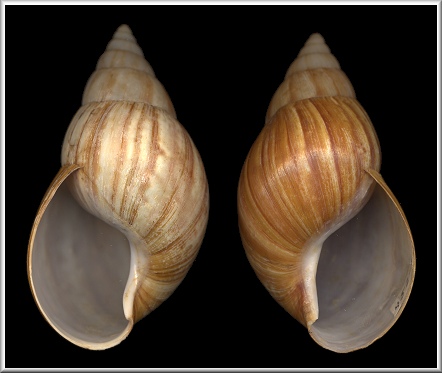|
Lissachatina fulica (Bowdich, 1822) |
|
(Sinistral Specimen On The Left) |
|
|
|
A note and some questions on the taxonomy and nomenclature of the Giant African Snail by Harry G. Lee
For most of century
following its description, the name Achatina fulica was
attributed to Férussac (1821: 49 <http://www.biodiversitylibrary.org/item/41533#page/133/mode/1up>:
see Fig. 1). As the reader can see, the Baron did indeed coin the
binomen based on material of Mauritian provenance without
description or figure but with an indication and mention of three
specimens he'd examined. Bequaert (1950: 55
<http://www.biodiversitylibrary.org/item/43478#page/57/mode/1up>)
stated
that there was "a doubtful reference to Martin Lister's pl. 578,
fig. 33." By this he meant that the Baron followed that indication
with a "?"
as can be seen in Fig. 1.
Bequaert declared it a "nomen nudum, not being
validly defined." In the literature, including Bequaert (1950), the
consensus identification of the 1692 Lister figure (Fig. 2; from my
microfiche edition) is A. fulica, and I see no reason to
break with convention on this matter.
However, the
position taken by the Code (ICZN, 1999: Article 72.4.1) is that any
bibliographic reference an author "doubtfully attributes to a
taxon" cannot be considered a type. What a difference one
punctuation mark can make!
¹Anachronisms of this sort are not uncommon in the classic literature; see the curious case of Plagioptycha strumosa (Reeve, 1852). Acknowledgments: The author thanks Paul Callomon (Academy of Natural Sciences [ANSP]) for posing the question that led to this analysis, Dr. Philippe Bouchet (Muséum National d'Histoire Naturel, Paris and ICZN Commissioner) for assistance interpreting The Code, Dr. Gary Rosenberg (ANSP and ICZN Commissioner) for bibliographic and nomenclatorial counsel, and Bill Frank (Jacksonville, FL) for many technical services. Literature cited: Anon., 1822. A list of donations to the library and museum of the Cambridge Philosophical Society. Transactions of the Cambridge Philosophical Society 1(2): 461- 464.
Bowdich, T.E.,
1822. Elements of Conchology. Part I. Univalves. J. Smith,
Paris. Pp. (1)-(78) + ii + 19 pls. w/ facing explanations.
<http://archive.org/details/elementsofconcho01bowd> Férussac [A.E.J.P.J.F. d’A.], Baron de, 1821. Tableaux systématiques des animaux mollusques classés en familles naturelles, dans lesquels on a établi la concordance de tous les systèmes; suivis d’un prodrome général pour tous les mollusques terrestres ou fluviatiles, vivants ou fossils. Premiere Partie Tableaux systématiques généraux de l’embranchemant divisés en familles naturelles Deuxième partie (premiere section.). Tableaux particuliers des mollusques terrestres et fluviatiles, présentant pour chaque famille les genres et espèces qui la composent. Bertrand, Paris. [j]-xlvij + [i] + [3]-27 + [3]-110 + [i]. <http://www.biodiversitylibrary.org/item/41533#page/9/mode/1up> ICZN (International Commission for Zoological Nomenclature), 1999. International Code of Zoological Nomenclature fourth edition. International Trust for Zoological Nomenclature. Pp. xxix + 1-306. Lamarck, J. B. P. A. de M. de, 1822. Histoire naturelle des animaux sans vertèbres présentant les caractères généraux et particuliers de ces animaux, leur distribution, leurs classes, leur familles, leurs genres, et la citation des principales espèces qui s'y rapportent; précédée d'une introduction offrant la détermination des caractères essentiels de l'animal, sa distinction du végétal et des autres corps naturels; enfin l'exposition des principes fondamentaux de la zoologie. [Première édition] Tome 6 Partie 2. Lamarck, Paris. i-vi + 1-232. April. <http://www.biodiversitylibrary.org/item/26549#page/357/mode/1up> Lister, M., 1685-1692. Historiae sive synopsis methodicae Conchyliorum. 4 vols. [First edition]. London. pp. 1-1000. See Assorted Worldwide Terrestrial Species for images of Lissachatina fulica from Micronesia, Samoa, Taiwan, St. Lucia, Ecuador, Barbados and Guadeloupe. |

